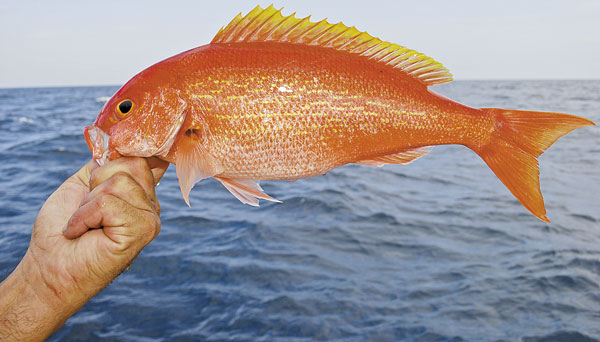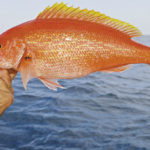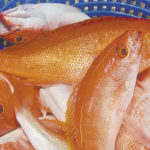
Is vermilion a shade of red? Not when the season on red is closed or the limit is so low it is almost embarrassing to admit you are targeting them. We are talking about snappers, of course — red snappers and vermilion snappers.
Red snappers have long been the glamour-girls of the clan. In the last decade, gray, or mangrove, snappers have come on strong in popularity ratings, trailed by a substantial margin by vermilion snappers, which are all three far ahead of the 11 other snapper species in the Gulf of Mexico.
This fish is known to scientists as Rhomboplites aurorubens. “Aurorubens” means “gold-red” in Latin, probably because the fish is indeed bright red with faint, broken gold bars running the length of the body and a bright golden-yellow margin on its dorsal fin. As for the meaning of the first name, your guess is as good as mine.
The fish is seldom known as vermilion snapper to recreational and commercial fishermen. Beeliner, sometimes spelled b-liner, is its most common moniker, but occasionally they are called mingos and, although I have never personally heard anyone use the term, “bastard snappers.”
Beeliners are not large fish. Interestingly, recreational fishermen catch smaller fish than do commercial fishermen, and recreational fishermen in the eastern Gulf (Florida and Alabama) catch higher numbers but much smaller-sized fish than do those in the western Gulf.
But even off Louisiana, where the fish are comparatively large, the average beeliner is less than 2 pounds. The Louisiana state record, caught off Grand Isle by Douglas Fussel in 1999, is 6.19 pounds. The IGFA all-tackle world record is only 7 pounds, 3 ounces. Larger fish do exist but are rare. Commercial fishermen, who take the lion’s share of the catch, talk about fish over 10 pounds.
The fact that beeliners grow fast and mature quickly is recognized by their minimum size for retention being only 10 inches. At one time it was 8 inches. It was increased to 10 inches, not from biological necessity but to get more pounds of production from the fishery. The average female matures at slightly less than 6 inches long and by age 1. Maximum age is 13 years old.
Written references state that beeliners spawn several times between April and September. My personal experience is that spawning takes place at night and is heaviest near a full moon. During that period, every male will be dripping sperm when it is brought on board.
In dietary habits, they are not as gluttonous as red snappers, nor as cautious as mangrove snappers. Their food choices most closely resemble those of the yellowtail snapper, and includes a lot of pinhead-size zooplankters and the larvae of shrimp, crabs and fish. They can and do, however, enthusiastically chomp down on cut bait dropped close to them. And therein lies the rub in catching this very common fish — finding them.
Pulling up to a convenient oil platform and dropping baits near it will yield only occasional beeliners. This seems to happen near the mouth of the Mississippi River more often than other areas. Beeliners will stack in schools, some of them immense, over bottom structure such as shipwrecks, or in Louisiana, over the large mini mountain-shaped extrusions we call lumps that are concentrated in 100-fathom depths.
The tops of these lumps may “only” be 400 feet down, but that isn’t necessarily were the beeliners will be. It isn’t at all uncommon for their school to be suspended 100, 200 or 300 feet down. Learning how to use a good depth finder is essential to finding these fish.
The other trick to catching them is to get them into a feeding frenzy. Commercial beeliner fishermen strongly believe that the more baits that can be kept in the water in front of feeding beeliners, the more aggressive their feeding will become and the more fish will be attracted to the frenzy. These guys, who are professionals at catching these fish, firmly believe in fishing hard to keep the bite going.
Another note of importance to those who aspire to become expert beeliner fishermen: More times than not, the best bite is at night.
All this sounds like a lot of trouble for a fish that seldom gets over 5 pounds. But there are two very good reasons, besides pride in fishing ability, to learn how to catch beeliners. First, they are excellent table fare. I find that their taste is so close to red snapper as to be almost indistinguishable from the big red one. But, I am in the minority. Most snapper aficionados swear they taste better than red snappers.
The other reason to learn how to target this fish is its very liberal bag limit. Red snapper bag limits can only be described as “anemic.” Many recreational fishermen assume that beeliners fall under the snapper aggregate limit of 10 fish. Not true. Beeliners, along with lane snappers (candy stripers), fall under the reef fish aggregate limit of 20, along with gray triggerfish, almaco jacks and all five species of tilefish.
So a skilled offshore angler could, if good enough, come home with a limit of two red snappers, 10 mangrove snappers and 20 beeliners per person.
Need to hear more?
Current federal size and bag limit information can be obtained on the web at www.gulfcouncil.org/Beta/GMFMCWeb/downloads/rec_brochure_2011.pdf
Jerald Horst is author of six books on fish and seafood, including the acclaimed Trout Masters: How Louisiana’s Best Anglers Catch the Lunkers. His latest book is Game Warden: On Patrol In Louisiana.




